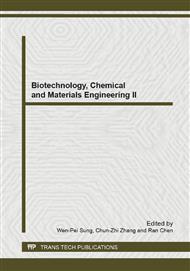p.329
p.333
p.338
p.342
p.346
p.351
p.355
p.363
p.367
Determination of Zirconium, Niobium, Vanadium and Chromium in the Titanium Ore by Microwave Digestion – ICP-OES
Abstract:
Abstract: Appropriate ratio of mixing digestion solvent which consist of HF and HNO3 have been tested firstly and combine with the high-pressure sealed microwave heating method, the titanium ore samples can be quickly and completely digested into solution. Then the elements content of zirconium, niobium, vanadium, chromium can be determined at the same time by applying the inductively coupled plasma atomic emission spectrometry (ICP-OES) method under hydrofluoric acid media condition.This method has solved the problem that the titanium ore matrix and impurities of zirconium oxide, niobium oxide, chromium oxide and other insoluble oxides are all difficult to digeste under normal conditions by the acid. Through fluoride ion complex reaction, make sure the easy hydrolysis of titanium ore matrix and niobium, zirconium and other elements to form the shape of the complex ion, even in the low acidity of the solution does not produce the hydrolysis reaction, so that it can greatly reduce the detection solution acidity to eliminate the blank background and acidity effects. The experiments investigated the impacts between the sample digestion conditions such as microwave heating procedures, reagents ratio, amount, and the titanium matrix as well as coexistent elements. Besides, it optimized the detection parameters of the ICP spectrometer under the conditions of using unconventional resistance to hydrofluoric acid PTFE nebulizer. Spectral interferences and matrix effects have been eliminated by selecting the appropriate analyte spectral lines as well as the integrated use of matrix matching and synchronization of the background correction method. The results show that the background equivalent concentration is 0.0002% ~ 0.0008%, and the detection limit is 0.0029 ~ 0.0018%, trace element recovery rate is 91.0% and ~108.0%, RSD is ≤ 4.71%.
Info:
Periodical:
Pages:
346-350
Citation:
Online since:
January 2013
Authors:
Price:
Сopyright:
© 2013 Trans Tech Publications Ltd. All Rights Reserved
Share:
Citation:


